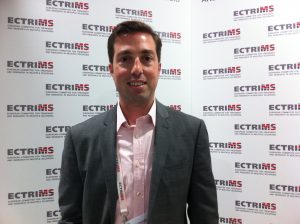#ECTRIMS2018 – Finding Best Treatment for ‘Right Patient’ and Progressive MS Among Work of Interest, Cleveland Clinic Doctors Say

ECTRIMS 2018 at City Cube, Berlin
Tailored, highly effective therapies early in the disease’s course may be a way forward in multiple sclerosis (MS) treatment, according to Cleveland Clinic neurologist Robert Bermel.
Another neurologist with the Cleveland Clinic, Robert Fox, talked about potential and upcoming progressive MS treatments.
In interviews with Multiple Sclerosis News Today at the recent 34th congress of the European Committee for Treatment and Research in Multiple Sclerosis (ECTRIMS) held in Berlin, Bermel and Fox also discussed stem cells and potential disease markers.
“Early, highly effective treatment would be a good idea in MS,” said Bermel, who is also the director of the clinic’s Mellen Center for Multiple Sclerosis. “The reason why we haven’t used that strategy for all patients in the past was because of issues of risk.”
Such concerns, he said, had clinicians preferring the so-called dose-escalation therapy approach, which starts with an “older, time-tested therapy — even if it’s not as effective” because it’s known to be safer, with fewer side effects.

Robert Bermel, a neurologist and medical director of the Mellen Center for Multiple Sclerosis. (Photo by Bionews Services)
But recent advances encourage a change in thinking.
“What’s evolved in last couple of years is the arrival of newer therapies of high efficacy and with what looks like have outstanding safety data as well,” Bermel said. Immune B-cell depleting therapies, especially Ocrevus (ocrelizumab, by Genentech), were key among these game-changers. Besides being more convenient for patients, as infusions are only given every six months, Ocrevus and other newer treatments “may actually be safer than some of our older therapies.”
Having about six or seven years of practice with oral therapies has brought “a comfort level with [their] safety profile,” Bermel said. Besides Ocrevus, he mentioned treatments that include Tecfidera (dimethyl fumarate) and Tysabri (natalizumab), both by Biogen; Gilenya (fingolimod) by Novartis; and Aubagio (teriflunomide), by Sanofi Genzyme.
In essence, it’s becoming easier “to weave through the potential risks and the potential benefits,” so as to provide patients with therapies that might be most effective early on, Bermel said.
Connect with other patients and share tips on how to manage MS in our forums!
“What we’re trying to do is match the right treatment to the right patient,” he added.
Finding the best approach
But treating patients, including those newly diagnosed, is a bit of “a trial and error approach,” Bermel said. This means that, for each patient, only time can tell how well a given treatment enables disease control.
Bermel is certain that early treatment is important to patients: If “we’re certain they’ve had a recent MS attack and we can with confidence make the diagnosis, we think that person should get on treatment right away, within a month or two of diagnosis,” he said.
But, he notes, what’s lacking is rigorous evidence as to which patients would be best served by early use of higher efficacy treatments as opposed to standard ones. “We’re testing that now” using two approaches, he said.
One is by randomized, controlled studies, such as two large clinical trials funded by the Patient-Centered Outcomes Research Institute (PCORI). Both will compare early, effective treatment use to dose-escalation approaches in patients with relapsing-remitting MS (RRMS). Within each treatment category, doctors and patients will choose the specific medicine used.
The first of these studies is the recently launched DELIVER-MS Phase 4 trial (NCT03535298), being conducted at the Cleveland Clinic in Ohio and at the University of Nottingham in the U.K.
A first enrollment, in what is expected to be an 800-patient study, will take place “probably this or next month,” Bermel said, adding that the Cleveland Clinic treats about 9,000 MS patients.
Scientists will primarily focus on changes in brain atrophy, or shrinkage, three years after starting the medication. “We want to know if starting a higher efficacy medicine first confers lower brain atrophy rates, basically.”
The second study, taking place at sites across 12 U.S. states, is called TREAT-MS (NCT03500328) and is led by Johns Hopkins University. Currently enrolling about 900 patients — more information is here — it will compare early use of more highly effective and standard first-line therapies in patients either at higher or lower risk of disability accumulation. Its goal is treatment impact on disability risk .
TREAT-MS will also analyze if switching from a first-line to a higher efficacy treatment after disease progression lessens disability risk compared to changing to a different first-line option.
Observational studies make up the other approach highlighted by Bermel. “We’re actively following thousands of patients in our clinic, who are everyday making these choices with their providers — either starting on standard efficacy therapy or high efficacy therapy,” he said.
“High quality data from clinical practice” may be pooled to determine how these patients do over time.
Work in progressive MS
While RRMS patients have various treatments available, those with progressive disease have more limited options. In fact, Ocrevus is their only specific disease-modifying medication, approved by the U.S. Food and Drug Administration for both forms of relapsing MS and primary progressive MS (PPMS) in March 2017.
“Clearly, our biggest unmet need is developing treatments for progressive MS. That is the biggest hole in our treatment armamentarium,” Fox said. Among other candidates, “ibudilast is a therapy that I’ve been involved in that looks promising,” he added.

Robert Fox, a neurologist with the Cleveland Clinic. (Photo courtesy of Cleveland Clinic)
In a recent interview with Multiple Sclerosis News Today, Fox discussed the findings of the 96-week Phase 2 SPRINT-MS study (NCT01982942), which reported that use of ibudilast — an oral treatment developed by MediciNova — slowed the progression of brain atrophy by 48 percent relative to placebo in patients with either primary or secondary progressive MS (SPMS).
Although a Phase 3 trial would be essential to properly assess therapeutic benefit, this result compared favorably with those of prior studies with Ocrevus in RRMS and progressive MS, and with the investigational progressive MS treatment siponimod (by Novartis), Fox said.
The U.K.-based Phase 2b MS SMART trial (NCT01910259), also detailed at ECTRIMS, compared the efficacy of three neuroprotective treatments — riluzole (marketed as Rilutek and Tiglutik for amyotrophic lateral sclerosis), the diuretic amiloride and fluoxetine — to placebo in 445 SPMS patients. Results failed to show therapeutic effect for either medication, but the design demonstrated “the utility of a four-arm trial that evaluates three different therapies,” he said.
MD1003, a high-dose biotin being developed by MedDay, may hold more “promise for progressive MS,” Fox said. Results of the MS-SPI trial (NCT02220933) showed that MD1103 lessened patients’ disability, especially with walking, over three years. The follow-on Phase 3 study, which is due to conclude in September 2019 according to the MS Society, may not have results ready for release at next year’s ECTRIMS, Fox said, but will more clearly define benefit.
“So, there is a lot that I think we’ll be seeing over the near future for therapies that may protect the brain in progressive MS,” he said.
Stem cells and disease markers
An alternative MS treatment strategy, but one with little presence at this year’s ECTRIMS congress, is stem cells. Work here as a way to go, Fox said, a point echoed by other MS researchers.
“The most promising part of stem cell therapy, to me, is not stem cells to go in and be neurons,” Fox said, “but rather stem cells that can provide some sort of growth, stabilization, something to make the brain a healthier place.”
Researchers still lack information on “what those molecules are,” and how to make the cells that might reach the brain and the spinal cord and provide therapeutic benefit. “We really don’t know,” Fox said.
Scientists are also looking to develop better markers of disease progression, damage, and treatment response. Serum neurofilament light (sNfL), a potential blood biomarker, has been a focus of studies as a relatively easy way to make such assessments — although outcomes to date are mixed.
“[sNfL] is our leading candidate biomarker for treatment response,” said Fox, who discussed sNfL in an interview with Multiple Sclerosis News along with neurologists Jerry S. Wolinsky and Bernd Kieseier. But besides not being specific to MS, sNfL still lacks a suitable assay and may be better for relapsing than for progressive forms of MS, the scientists noted.
Fox sees more likely progress — at least for the near future — coming out of work into advanced imaging approaches, like those explored in the SPRINT-MS trial of ibudilast. “Cortical atrophy,” Fox said, “showed particular promise as being a sensitive measure of a treatment response, at least a treatment response in progressive MS.”
Overall, advanced imaging approaches may help find “a more sensitive measure of neuroprotection so that we can do trials more quickly and with fewer patients,” he concluded.






